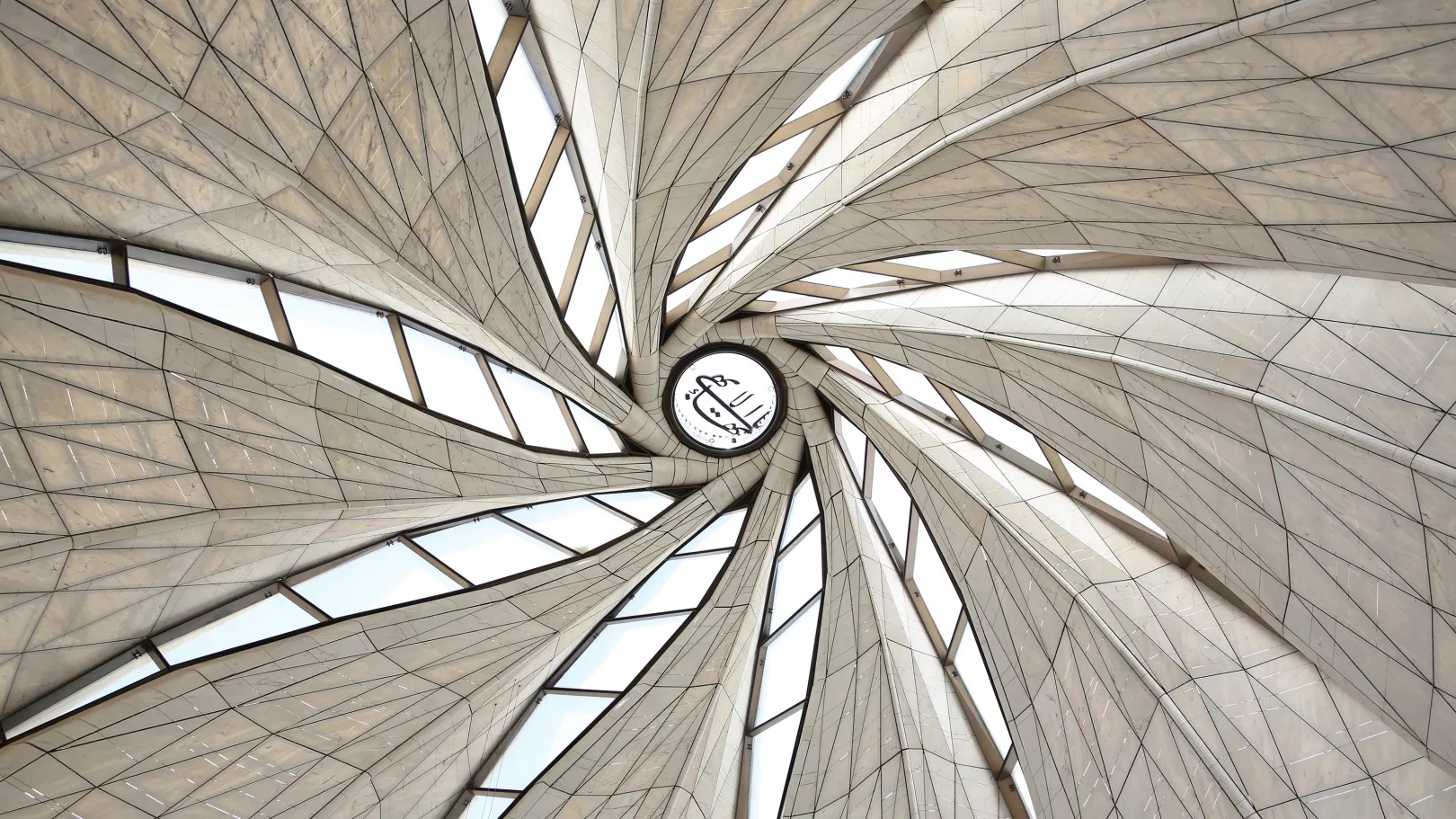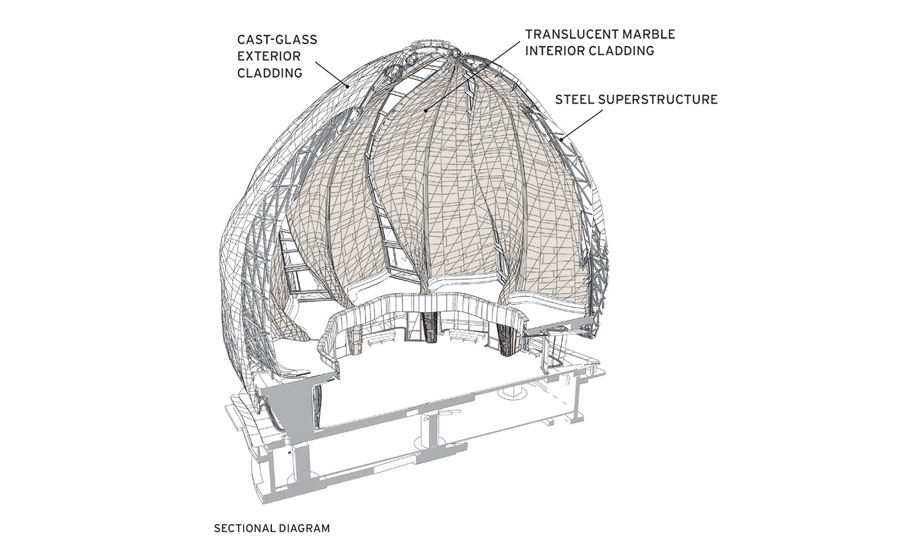Architectural Details: The Translucent Marble and Slumped Glass of Bahá’í Temple

Architects: Find the perfect materials for your next project through Architizer. Manufacturers: Sign up now to learn how you can get seen by the world’s top architecture firms.
When harnessed to maximum effect, light can give shape to form and space. Inspired by light as a material in itself, Hariri Pontarini Architects‘ A+Award-winning Bahá’í Temple of South America was borne from an exploration of cast glass and translucent Portuguese marble. Comprising nine monumental glass veils, the worship space is designed to express an inclusive faith.
Embodying a community’s aspirations, the temple is set within the foothills of the Andes bordering the metropolis of Santiago, Chile. 14 years in the making, the project represents the last of eight continental temples commissioned by the Bahá’í Community. The open and accessible space has become a major destination in South America since its opening in 2016, now welcoming up to 36,000 visitors each weekend.
 Conceptually, the project encapsulates the interplay of contradictions: stillness and movement, simplicity and complexity, intimacy and monumentality; a solid structure capable of dissolving in light. Surrounded by reflecting pools and a landscape of native grasses, the Bahá’í Temple is a domed, luminous structure that echoes the rolling topography of the Andes.
Conceptually, the project encapsulates the interplay of contradictions: stillness and movement, simplicity and complexity, intimacy and monumentality; a solid structure capable of dissolving in light. Surrounded by reflecting pools and a landscape of native grasses, the Bahá’í Temple is a domed, luminous structure that echoes the rolling topography of the Andes.
Built to last 400 years, the temple was designed to draw humanity closer to the Divine, to that quest for personal and collective perfection, betterment, refinement and a longing for togetherness and unity. Stone, glass, wood and steel become spiritual, and in turn, the measurable becomes immeasurable.
 An investigation into material qualities that embody light culminated in the development of two cladding materials: translucent marble from the Portuguese Estremoz quarries for the interior layer, and cast glass panels for the exterior.
An investigation into material qualities that embody light culminated in the development of two cladding materials: translucent marble from the Portuguese Estremoz quarries for the interior layer, and cast glass panels for the exterior.
Designing a structure as complex and varied as nature required the most advanced computer technology. Led by Siamak Hariri, the team at Hariri Pontarini Architects innovated its own system for rendering the sculptural building, using machine-to-machine fabrication to create highly irregular, organic shapes in glass.

 The exterior layer of cast-glass panels was developed in collaboration with the Canadian glass artist Jeff Goodman. Around 20 percent of the exterior cladding is curved, with the curved glass pieces made by slumping flat glass over shotcrete-covered polystyrene forms in a kiln.
The exterior layer of cast-glass panels was developed in collaboration with the Canadian glass artist Jeff Goodman. Around 20 percent of the exterior cladding is curved, with the curved glass pieces made by slumping flat glass over shotcrete-covered polystyrene forms in a kiln.
The glass casting was completed by Goodman and CGD Glass, while the fabrication was done by EDM. The team used borosilicate glass for the site’s extreme temperature variations. Standing next to the temple, visitors can appreciate the complex subtlety of the exterior cladding manufactured from this melted glass, which recalls the configuration of snowflake crystals.

 Meanwhile, translucent marble panels form the interior walls of the temple. Flat pieces were water-jet cut from slabs to the exact shape defined by the computer model. Each wing of the nine-sided Temple contains over 870 unique pieces of marble.
Meanwhile, translucent marble panels form the interior walls of the temple. Flat pieces were water-jet cut from slabs to the exact shape defined by the computer model. Each wing of the nine-sided Temple contains over 870 unique pieces of marble.


The final fabrication of the steel superstructure — manufactured by Gartner Steel and Glass — was made possible only through advanced fabrication techniques. The multitude of parts was assembled in Germany into manageable sections, and then shipped and assembled on site in Chile.
The Temple is designed to withstand extreme earthquakes and wind. The super-structures of the wings are comprised of hundreds of unique, individually engineered slim-profile steel members and nodal connections. Each of the wings rest on concrete rings and columns on elastomeric seismic isolators, so that in the event of an earthquake, the concrete pads slide horizontally to absorb the shock.


Openness and transparency are fundamental to both the structure and its site. The Bahá’í House of Worship can be accessed by nine entrances located at regular intervals around the domed structure, while curving paths lead visitors on walking meditations through the sloped landscape.
The building combines advanced engineering solutions, cutting-edge material innovation, and computerized fabrication methods to create a space that is at once monumental and intimate. The structure works with the idea of light being captured, embodied and catalyzed within the material structure of the temple.
As a result, the Bahá’í Temple is alive with light.
Find all your architectural materials through Architizer: Click here to sign up now. Are you a manufacturer looking to connect with architects? Click here.
The post Architectural Details: The Translucent Marble and Slumped Glass of Bahá’í Temple appeared first on Journal.
, Eric Baldwin, read more Journal http://bit.ly/2F8pjhp
Yorumlar
Yorum Gönder